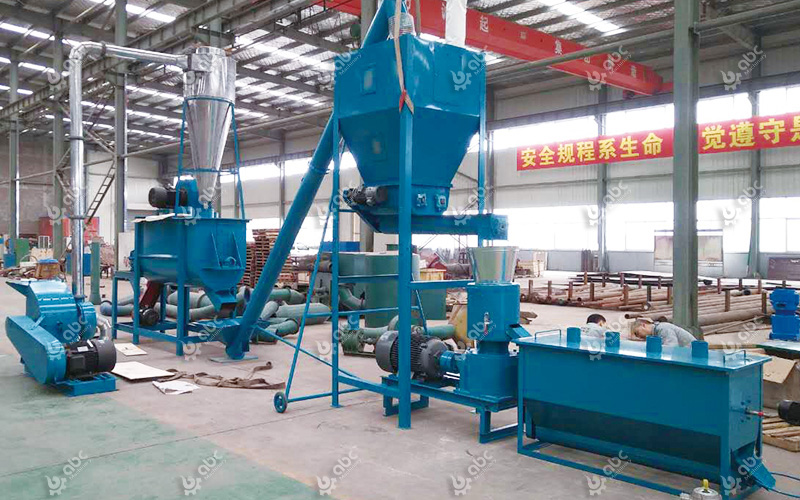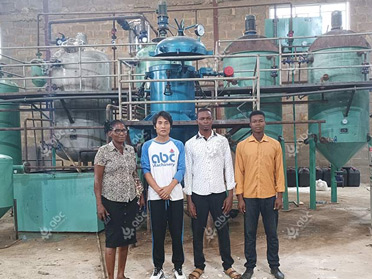When using animal feed processing machine to make poultry and chicken feed pellets, the formula is very comprehensive in terms of nutrition, thus allowing the chickens to avoid picky eating. As the livestock and poultry feed is basically in the form of pellets, it can be kept even in all processes, thus reducing unnecessary losses and saving transportation costs. At the same time, the correct use of the poultry feed pellet mill can improve the material utilisation rate and increase revenue for farms or factory.

Starting Business by Setting Up Poultry Feed Mill
During the processing of poultry feed pellets, a series of reactions occur in the feed due to the influence of moisture, temperature and pressure, which is beneficial to digestion. This, coupled with the fact that poultry feed pellet has good fluidity and almost no sticking, is one of the reasons why it attracts more and more customers to make their own poultry feed pellets or just start poultry feed pellet production business. The feed processed by the livestock pellet feed production machine is not as easy to classify as powder, not easy to raise dust and relatively less environmental pollution, which is in line with the concept of environmentally friendly production. (Read more: Animal Feed Production Business Plan >>)
1~10TPH Poultry Feed Mill Plant for Sales
This chicken feed mill plant designed by ABC Machinery is suitable for small or medium sized agricultural breeding plants. It can not only make animal feed pellets for chickens, ducks, geese, rabbits, pigs, cattle, sheep, but also can produce sinking feed pellets for aquatic animals, like fish, crabs, etc. In addition to feed pellets, it can also be used to make powered feed, crumble feed as well as lumpy feed by adjusting some equipment. (Latest news: Cost of Setting up Poultry Feed Mill in Nigeria >>)
ABC Machinery, one of the leading poultry feed mill equipment manufacturer in China, has rich and practical experiences in helping customers to setting up a poultry feed mill business. If you are interested in knowing the feed plant layout and design, working process, total cost of this poultry chicken feed mill plant, just contact us to get customized answers!
Cost & Profit to Start Poultry Feed Manufacturing Business
| Capacity | Factory Site | Equipment Production Cycle | Onsite Project Installation Cycle | Investment Cost | Profit Cycle |
|---|---|---|---|---|---|
| 1-2T/H | 300-500 m² | 15 Days | 7-15 Days | 12,000-50,000 USD |
1-3 Year |
| 3-4T/H | 300-700 m² | 15 Days | 15-20 Days | 50,000-120,000 USD | |
| 5-7T/H | 400-800 m² | 20-30 Days | 20-40 Days | 70,000-250,000 USD | |
| 8-10T/H | 800-2000 m² | 30-40 Days | 45-60 Days | 150,000-300,000 USD |
Cost Determination Factors of Setting up Poultry Feed Mill
The total investment cost is especailly critical for poultry feed mill plant setup. In fact, there are many factors that can infact the investment cost, like capacity, equipment, final animal feed types and more. In most cases, the cost to setup a complete livestock or poultry feed pellet mill plant is higher than the premix feed production plant and the powder feed production plant.
Profitability Analysis for Poultry/Chicken Feed Mill Factory
1). Local Economic Level: It will determine the price of raw materials to produce animal feed and the price of animal feed sold on the market.
2). Factory Operation Level: the daily operation cost, like electricity, water and etc., equipment wearing parts, the proficiency of workers and the management, etc.
Process Design and Equipment for Poultry Feed Mill
Generally, a complete poultry feed pellet production line is designed with typical animal feed manufacturing process, including crushing, mixing, pelletizing, cooling, screening, packaging, etc. We can offer solutions for your poultry feed pellet manufacturing request according to your raw material size and specific requipments. (Latest project report: Poultry Feed Manufacturing Plant Cost in Uganda >>)

Factory Design for Small Poultry Feed Mill Machinery
- Raw Materials Crushing - Crusher/Hammer Mill
The raw materials in the crushing bin are fed into the crusher to be crushed into powdery raw materials, and then distributed to each batching bin according to the variety of raw materials through the conveyor. The purpose of crushing is to increase the specific surface area of the feed and improve the utilization rate of the feed by the animals. Increase the contact area of digestive enzymes with raw materials, reduce the energy consumption of chewing during the feeding process of animals, and help improve the feed reward. The pulverized raw materials are easy to mature in the granulating and tempering stage, and the pulverized feed can be greatly increased in the granulating process. The power consumption is greatly reduced, which can improve the quality and work efficiency of the subsequent processes.
- Crushed Material Mixing - Mixer
The process of uniformly mixing the raw materials weighed by the batching scale. A good mixer can mix the feed evenly in a short period of time. Poor mixing will lead to deterioration of product quality and affect feed effect. The mixing should be controlled well, and the uniformity will gradually reach the appropriate uniformity with the increase of the mixing time, but if the mixing time is extended after the mixing is uniform, the phenomenon of raw material stratification will occur. The feeding sequence of the mixer: the raw materials with a large amount in the formula are added first, and then the trace elements are added. The large particle size is added first, followed by the small particle size, and the small specific gravity is added first, followed by the large specific gravity, and try to avoid layering (The reason why chicken feed is easy to stratify) The particle size of each raw material in the mixture should be close to each other, and adding oil can reduce the stratification of raw materials. Avoid over-mixing, and release the product before reaching the appropriate mixing time, so as to complete the mixing during the transportation process, and install anti-stratification equipment during the transportation process after mixing to shorten the storage time of the product in the silo as much as possible. (Related news: Factory Price Poultry Feed Mixer Machine to Kenya >>)
- Feed Pelletizing - Pellet Mill
The mixed powder feed is processed into pellet feed. Feed pelleting is easy to digest. During the pelleting process, starch-based raw materials must be stirred for a period of time with a suitable amount of water at high temperature. Starch raw materials will be ripened, softened and bonded, and the mechanical energy generated during granulation can increase the degree of damage to the raw materials and make it easier to digest. If the feed is easier to digest, the animal can absorb its nutrients more and faster, and the "feed to meat ratio" will be lower,and the taste is good. Through high temperature, the granules have fragrance and taste better. During the pellet, other materials can be sprayed on the surface of the granules, and the taste is better. The nutrients are more uniform: the raw materials in the formula can be mixed together, so that each granule can achieve stable nutritional components, and animals cannot choose when eating, and the composition of the formula can choose a variety of raw materials. Pelletizing increases the density of pellets, and the extruding of the ring die makes his density higher, thereby improving the storage capacity of the silo. The pellets have little loss during transportation, and the fluidity is good and convenient for transportation. It is suitable for automatic feeding systems. Eliminates some viruses because the high temperature kills the toxins in the raw material, making the pellets safer for animals. (Related post: Formula for Making Chiken Broiler Feed >>)
| Poultry Feed Mill Machine | Capacity | Pros | Cons |
|---|---|---|---|
| Flat Die Feed Pellet Mill | 60~1000 KG/H | Easy operation; Flexible production; Cheap price | More suitable for small scale animal feed production; |
| Ring Die Feed Pellet Mill | 1~12 T/H | Efficient feed prodution; Has the option for conditioning and tempering; | Suitable for small, medium and large scale animal feed plant; |
Small Poultry Feed Mill Machine for Sales

The mixed material enters the pellet system, and the rotary distributor located at the upper part of the pellet system evenly spreads the material on the surface of the die, and then presses the material into the die hole by the rotating press and mixes it and presses it out from the bottom, The rod-shaped feed coming out of the die hole is cut into the required length by the cutting roller.
Commercial Chicken Feed Making Machine at Factory Price

The uniformly quenched and tempered materials are first removed by the security magnet, and then evenly distributed between the pressing and mixing and the pressing die, so that the material enters the pressing area from the pressing area of the feeding area, and is continuously squeezed by the pressing roller into the die hole. It is divided into columnar feed, and as the die rotates, it is cut into pellet feed by the cutter fixed outside the die.
Conditioning and tempering: After the powder leaves the mixer and before entering the granulation chamber, the usual method is to inject steam into the conditioner, so that the feed and steam are mixed and stirred, and the process of moist heat exchange (Conditioning and tempering is the key link in the production of pellets, and the effect of conditioning directly determines the quality of the product and the production capacity of the pellet machine).
How does a Poultry Feed Mill Work?
ABC Machinery can offer one-stop service for your needs of animal feed processing. We not only sell single set of chicken feed making machines, but also can offer one-stop service of poultry feed mill plant setup. Our poultry feed mill equipment has been exported to many regions, like Australia, Ghana, Uganda, Kenya, Nigeria, Japan, Philippines, Thailand, Kuwait, etc. For more information about the equipment price and project cost, please feel free to contact us!
- Pelleted Feed Cooling - Cooler
During the granulation process, due to the introduction of high-temperature and high-humidity steam and the extrusion of the material, a large amount of heat is generated, so that when the pelleted feed comes out of the granulator, the water content reaches 16%-18%, and the temperature is as high as 75 °C -85°C, under this condition, the pellet feed is easily deformed and broken, and the phenomenon of sticking and mildew will also occur during storage. The moisture must be reduced to below 14%, and the temperature must be reduced to below 8 °C higher than the air temperature. so it needs to be cooled
- Feed Screening & Packaging - Sieve & Packaging Machine
After the pellet feed is processed by the crushing process, a part of powder clots and other materials that do not meet the requirements will be produced. Therefore, the crushed pellet feed needs to be screened into products with neat particles and uniform size. Finished product packaging process: The finished product is weighed, bagged, and seamed by automatic packaging equipment. Generally, finished products are delivered in two forms: bulk and bagged. Domestically, due to the limitations of conveying equipment and large-scale feeding, bags are mostly used. The automatic weighing system can weigh different specifications of feed according to customer needs.

 Build Your Future!
Build Your Future!













